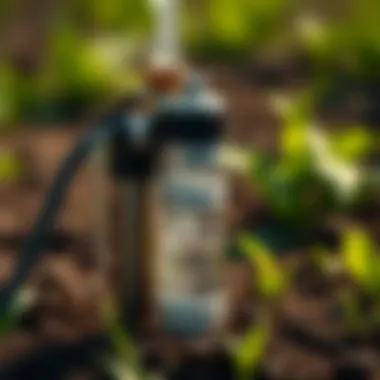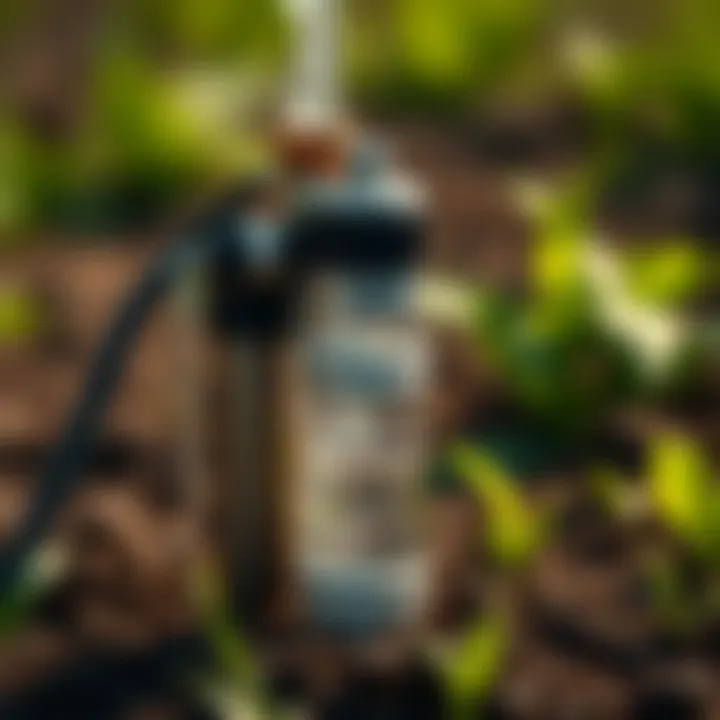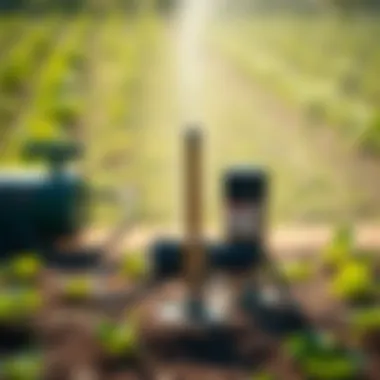Understanding the Impact of Small Water Pumps in Irrigation


Intro
Irrigation is a lifeline for agriculture, enabling farmers to grow crops in diverse climates and geographies. Among the various technologies that support efficient irrigation, small water pumps play a pivotal role. These pumps don't just move water from one place to another; they do so with a blend of functionality and adaptability that benefits not only individual farms but also entire agricultural practices. Understanding how these machines can influence productivity and sustainability is crucial for anyone involved in farming.
Small water pumps come in various shapes and sizes, designed to meet a range of irrigation needs. They can be electric, diesel-powered, or even solar-powered, making them accessible in both developed and developing regions. In rural communities, where water resource management is paramount, the right pump can make all the difference in crop yield and resource conservation.
This article will provide a thorough overview of small water pumps, focusing on key insights into their design, the importance they hold in agriculture, sustainable practices associated with their use, and the tools and resources available for farmers and enthusiasts alike.
Key Insights
Overview of the Topic
Small water pumps are designed to efficiently move water for irrigation, ensuring that plants get the moisture they need for optimal growth. Their innovative designs—ranging from centrifugal to submersible pumps—address various agricultural requirements. Each pump type offers unique features tailored to specific water sources and volumes, which makes them versatile tools for farmers.
Importance in Agriculture/Horticulture/Agronomy
The significance of small water pumps in agriculture cannot be overstated. Here are some of the critical benefits they provide:
- Increased Efficiency: With advancements in technology, modern pumps optimize water usage, reducing waste and enhancing delivery systems.
- Accessibility: By enabling irrigation in areas with limited access to water, these pumps open up new agricultural possibilities.
- Support for Sustainable Practices: Many small pumps are designed to work with renewable energy sources, thus reducing the carbon footprint associated with traditional agricultural practices.
"Utilizing small water pumps can dramatically transform an agricultural landscape, turning barren land into fertile ground."
Farmers equipped with the knowledge to harness these valuable machines can significantly increase their productivity while contributing to more sustainable farming methods. The journey into the world of small water pumps reveals a tapestry of innovation that enhances not just individual farms but the broader agricultural community.
Understanding Irrigation Needs
Irrigation is the lifeblood of agriculture, serving as a crucial method for supplying crops with the right amount of water. It ensures the optimal growth of plants and sustains agricultural output, especially in areas where rainfall is sparse or unpredictable. To grasp the significance of small water pumps within this framework, one must first appreciate the broader context of irrigation needs.
Purpose of Irrigation
The primary goal of irrigation is to provide adequate moisture to plants at various growth stages. This is vital because most crops have specific water requirements for germination, flowering, and fruiting. Moreover, effective irrigation helps mitigate the risks of drought, ensuring food security in regions heavily reliant on agriculture. When farmers manipulate water availability through tailored irrigation strategies, they can achieve higher yields and maximize profits. However, understanding these dynamics requires analyzing not just the techniques, but also the systems that facilitate effective water management.
Types of Irrigation Systems
When it comes to irrigation, several systems have been developed, each with its strengths and weaknesses. Understanding these different types is key, especially as small water pumps play a role in their functionality. Here’s a closer look at three primary systems:
Drip Irrigation
Drip irrigation is often lauded for its efficiency. This system delivers water directly to the root zone of plants through a network of tubes and emitters. The defining characteristic of drip irrigation is its ability to minimize water wastage by targeting plant roots rather than saturating the surrounding soil. The unique advantage of this method is that it drastically reduces evaporation and runoff, conserving water while promoting healthier plant growth.
However, installing a drip system can initially be costlier than other methods. Farmers must weigh these upfront costs against long-term water savings and potential yields.
Surface Irrigation
In contrast, surface irrigation, sometimes known as flood irrigation, applies water directly to the soil surface, allowing it to flow into the soil via gravity. One key characteristic of surface irrigation is its simplicity; it does not require complex equipment like pumps or timers. As a result, it tends to be less expensive for farmers who are starting in regions where water is plentiful.
Nonetheless, the unique challenge with surface irrigation is managing runoff and ensuring even water distribution, which can lead to inefficiencies and soil erosion if not monitored carefully. Thus, this method is often best suited for flat terrains.
Sprinkler Systems
Lastly, sprinkler systems offer a versatile approach to irrigation by spraying water over crops, mimicking natural rainfall. This system is particularly useful for covering large areas and can be adapted for varying field shapes and sizes. The flexibility and mobility of sprinkler systems make them a favored choice among farmers who are looking to divert water from convenient local sources.
However, one major disadvantage is that they can incur higher operational costs due to energy consumption and maintenance needs. Additionally, factors such as wind may affect performance and lead to water loss.
Small Water Pumps Defined
Small water pumps play a crucial role in the agricultural landscape, especially in irrigation systems. Their design, functionality, and adaptability make them indispensable tools for farmers seeking to optimize their water usage. These pumps can maneuver water efficiently from various sources, ensuring crops receive the necessary hydration without excessive wastage. Their versatility stands out in contrast to larger counterparts, which might be more suitable for extensive industrial applications. In this section, we will delve deeper into the characteristics of small water pumps and explore how they stack up against larger pumps in the context of irrigation.
Characteristics of Small Water Pumps
Small water pumps typically range in size and output, but they share certain fundamental characteristics that make them ideal for irrigation. Here are some key features:
- Portability: Many small water pumps are designed to be lightweight and easy to transport. This allows farmers to access different fields or water sources without substantial effort.
- Energy Efficiency: These pumps often consume less power, making them economical options for continuous water supply.
- Diverse Applications: They can be used for various irrigation methods, such as drip, surface or sprinkler systems, catering to different agricultural needs.
- User-friendly Designs: Generally, they have simple operational mechanisms that do not require extensive training for efficient use.
- Durability: Despite their size, many small water pumps are built to withstand the rigors of outdoor use, resistant to corrosion and wear from water exposure.
Understanding these characteristics can guide farmers in selecting the right pump for their irrigation needs. They must consider how these features meet their particular requirements, especially concerning land type and crop hydration needs.
Comparison with Larger Pumps
While both small and large water pumps serve the purpose of transporting water, their applications often differ significantly. Here’s a comparative look at their functionalities:
- Capacity: Larger water pumps typically handle much higher volumes of water, making them suitable for extensive or industrial-scale irrigation systems. In contrast, small water pumps focus on targeted, precise watering.
- Cost: Smaller pumps usually have a lower initial investment cost and maintenance expenses compared to larger pumps, which may require more complex infrastructure and higher running costs.
- Installation Requirements: Larger pumps often necessitate specific installation conditions, including plumbing and electrical setups. Meanwhile, small water pumps allow for simpler installation, often requiring little more than placement near a water source.
- Sustainability: Small pumps can be more easily integrated into sustainable irrigation practices, particularly when powered by renewable energy sources such as solar power.


“The size of the pump should align with the needs of the farm; sometimes less is more when it comes to irrigation.”
In summary, small water pumps serve a vital purpose in irrigation, aiding in water management even in limited spaces. Their characteristics make them particularly appealing in growing environments where adaptability and efficiency are paramount. By assessing the differences between small and large pumps, farmers can make informed decisions that best suit their agricultural practices.
Types of Small Water Pumps
Small water pumps play a pivotal role in irrigation, serving as the muscles behind efficient and effective water management practices in agriculture. Understanding the different types of small water pumps is essential for farmers and growers as they evaluate their irrigation needs. Each type has unique characteristics that make it suitable for specific watering tasks and conditions, contributing to their operational success.
Submersible Pumps
Submersible pumps are designed to function underwater, drawing water from a well or reservoir below the surface. They are compact and efficient, which makes them a preferred choice for many agricultural applications. When submerged, these pumps push water to the surface using an impeller system, providing a reliable flow without the need for priming. This feature saves time and energy, especially for farmers in remote areas where resources are limited.
- Advantages:
- High efficiency in drawing water from depths.
- Reduced risk of cavitation, a common problem in above-ground pumps.
- Ideal for both fresh and saltwater applications.
One important consideration with submersible pumps is their installation depth. Proper assessment of the site is crucial to ensure that the pump operates effectively and does not experience undue wear and tear from sediment or debris. Maintenance, while generally minimal, should include regular checks to avoid fouling of the pump's components.
Centrifugal Pumps
Centrifugal pumps operate by converting rotational energy into the kinetic energy of the fluid. They are often used in surface irrigation systems due to their ability to handle large volumes of water at relatively low pressures. These pumps are widely utilized because they can be easily integrated into various irrigation setups. Their straightforward mechanics allow for ease of operation and maintenance.
- Key Features:
- Highly versatile, suitable for different types of irrigation systems.
- Cost-effective for large-scale applications.
- Streamlined design that allows for quick repairs.
However, while centrifugal pumps excel in transferring water over moderate distances, they are less effective at pulling water from deep sources compared to submersible pumps. Farmers often opt for these when the water source is accessible, balancing their pumping needs with convenience and installation costs.
Diaphragm Pumps
Diaphragm pumps are a relatively novel option in the pumping world, standing out for their ability to handle a variety of fluids, including chemicals and slurries, without contamination. They operate using a flexible diaphragm that moves up and down, creating a vacuum to draw water in and then pushing it out. This pumping method prevents backflow, ensuring that the sprinkler systems or drip lines receive a steady flow of water.
- Benefits Include:
- Excellent for precision irrigation tasks, like fertigation.
- High resistance to corrosive substances and contaminants.
- Capable of working with fluids of varying viscosity.
The adaptability of diaphragm pumps makes them an excellent choice for specialized agricultural practices that require careful water management. Regular maintenance of these pumps focuses on monitoring diaphragm wear and ensuring that the valves are functioning correctly.
Overall, understanding the nuances between submersible, centrifugal, and diaphragm pumps can greatly empower farmers in their choice of irrigation solution. Each type has clear advantages and applications, allowing for tailored approaches to suit specific agricultural needs. By gaining knowledge of these pumps, farmers can optimize their irrigation efficiency, save resources, and ultimately enhance their crop yield.
Benefits of Utilizing Small Water Pumps
Small water pumps play a pivotal role in modern irrigation systems, perfectly tailored to meet the specific needs of farmers and agricultural enthusiasts. Understanding their benefits can significantly enhance irrigation efficiency, cost management, and operational flexibility. With the constant demands of agriculture, especially in regions with variable climates or limited access to larger irrigation systems, small pumps stand out as a reliable solution. This section will explore three key advantages: efficiency in water use, cost effectiveness, and flexibility and mobility.
Efficiency in Water Use
One of the foremost advantages of small water pumps is their capacity for efficient water usage. Traditional irrigation systems often lead to over-watering or under-watering, which can stress plants and lead to lower yields. Small water pumps, on the other hand, can be precisely calibrated and positioned to meet the specific hydration needs of various crops.
- Small pumps allow for targeted irrigation, which minimizes water wastage.
- The adoption of drip and micro-irrigation systems further maximizes the efficiency provided by small pumps, ensuring that each drop of water counts.
Utilizing small water pumps can lead to improved plant health and yield. The precise application of water promotes deeper root growth, allowing crops to better tolerate periods of drought. This approach not only conserves water but also enhances soil health in the long run.
"Efficient water usage is not just about saving resources; it's about nurturing a sustainable future for agriculture."
Cost Effectiveness
Cost is an inevitable consideration for any farming operation, and small water pumps are undeniably wallet-friendly. With the price of water and energy being a growing concern, the operational costs of irrigation can quickly escalate. Here’s how small pumps help mitigate these expenses:
- Lower Initial Investment: Compared to larger pumps, small water pumps usually have a lower purchase price which is particularly appealing for small-scale farmers.
- Reduced Energy Consumption: Many small pumps are designed to be energy-efficient; using them can lead to a noticeable reduction in electricity bills, especially when options like solar-powered pumps are considered.
Moreover, the maintenance costs associated with small water pumps are typically lower. They are simpler devices, which often means they require fewer repairs and less frequent servicing, ultimately saving farmers both time and money.
Flexibility and Mobility
In the realm of farming, flexibility is essential. Small water pumps excel in providing mobility, allowing farmers to irrigate various areas without being tied down to a fixed location. The inherent portability of these pumps offers several advantages:
- Adaptable Installation: Small pumps can be easily relocated to serve different parts of a farm, depending on seasonal needs or crop rotations.
- Ease of Storage: When not in use, these compact pumps take up little space in a barn or shed, making storage simple and efficient.
- Responsive to Changing Conditions: With the unpredictability of weather patterns, small water pumps allow for on-the-fly adjustments to irrigation plans, ensuring that crops receive adequate moisture regardless of external conditions.
The combination of these benefits showcases how small water pumps are more than mere tools; they represent a shift towards smarter, more sustainable agricultural practices. Leveraging small water pumps can set the stage for a more productive and environmentally-conscious farming future.
Key Features to Consider
When selecting small water pumps for irrigation, recognizing their key features is paramount. Understanding these features can lead farmers to make informed decisions, ensuring that the pumps they choose are both practical and efficient in meeting their farming needs.


Power Source Options
Electric
Electric pumps have become the go-to choice for many agricultural enthusiasts. One significant advantage is their reliability; they can efficiently operate with a consistent power supply, making them a crowd favorite for farms located near electrical grids. Another notable aspect is their ease of use—just plug it in and go. On the downside, electric pumps may not be highly suitable for remote areas without power access, limiting their versatility.
If we delve deeper into the performance aspect, electric pumps can also handle larger water discharge rates compared to some alternatives, making them immensely beneficial for comprehensive irrigation schemes.
Solar
As the world becomes increasingly eco-conscious, solar-powered pumps are gaining traction. The primary attraction of solar pumps lies in their sustainability; they harness the sun’s rays, reducing reliance on traditional energy sources. This can be a significant money-saver in the long run and has led to a notable uptick in their adoption among small-scale farmers.
However, there’s a unique challenge related to solar pumps: they depend heavily on sunlight, which may not be available during cloudy days or at night. As such, having a backup system or considering local climate conditions is prudent when opting for solar.
Gas
Gas-powered pumps are quite popular among farmers who need reliable and portable equipment. These pumps aren’t hindered by power outages, unlike electric variants. Their portability is a key characteristic; just fill the tank and start it up, and you're good to go. This can be beneficial for farmers working on multiple plots without access to electricity.
On the downside, gas pumps can introduce concerns regarding combustion emissions. With a growing focus on environmental impact, reliance on gas-powered equipment might not align with a farmer's desire to maintain sustainability within their practices.
Pump Capacity and Performance
When selecting a pump, its size and capacity are crucial elements. The pump must meet the irrigation requirements without compromise. A too-small pump can lead to underperformance, jeopardizing crop yield. Conversely, an oversized pump can lead to excessive energy consumption and increased costs. It’s essential to evaluate the area to be irrigated and calculate the necessary flow rate.
Durability and Maintenance Needs
Durability is often a reflection of a pump's material quality and design. A robust pump withstands outdoor elements, such as moisture and temperature fluctuations. Additionally, low-maintenance designs rank highly among farmers. Routine checks on seals, filters, and impeller wear ensure that pumps run smoothly without unexpected down time, ultimately saving costs and efforts in the long run.
In summary, understanding these components plays a vital role in enhancing irrigation practices, making small water pumps more effective in agricultural settings.
Installation Considerations
When it comes to implementing small water pumps in irrigation systems, installation considerations can't be overlooked. These factors play a critical role in ensuring the pumps function efficiently and effectively. A thoughtful installation process not only maximizes the pump's performance but also enhances the overall irrigation setup. Let's dive deeper into what needs to be assessed and set up properly.
Site Assessment
The first step in any irrigation project is conducting a thorough site assessment. This evaluation involves understanding the geographic and environmental factors that might affect water delivery. Factors such as the land's topography, soil type, and existing water sources need to be carefully analyzed.
- Topography: The slopes and elevations of the land tell a lot about how water will flow. Proper knowledge here helps to decide on pump placement and whether additional structures, like barriers, are needed to prevent erosion.
- Soil Type: Different soils absorb water at different rates. If you’ve got sandy soil, it drains quicker than clay-heavy soil, which can hold water. This varies how you need to set up your irrigation system and, subsequently, where your pump should be anchored.
- Water Sources: It’s vital to identify the nearest water source, whether it be a stream, well, or reservoir. Understanding water availability is crucial for a smooth operation of the pump system.
Aligning these elements ensures that the irrigation system will work harmoniously with nature rather than against it. As a rule of thumb, if the ground is too uneven or the soil insufficiently absorbs water, the system might end up being quite inefficient. Keeping an eye on these aspects can save a lot of headaches down the line.
Infrastructure Requirements
Next up, we have to discuss the infrastructure requirements necessary for the successful installation of your small water pump. This covers everything from the physical structures which support the irrigation setup to the technical requirements necessary for the pump's efficiency.
- Access Roads: Implementation of access roads might be needed to transport equipment. Heavy-duty pumps may require vehicles and tools that can't traverse rough terrain. Thus, ensuring that there’s a clear path can make the job easier.
- Power Source: Depending on the type of pump selected, a reliable power source must be arranged. For some, that's electricity; others might benefit from solar energy. Assessing the availability of these energy sources on site is crucial.
- Connections: There should be a well-planned network connecting the pump to the various irrigation lines. This arrangement must facilitate easy and efficient water distribution across the fields. Incorrect connections can lead to leaks or inefficient coverage, causing water waste.
- Drainage Systems: Installing proper drainage will prevent flooding and ensure that surplus water is channeled away. This keeps the land suitable for crops and avoids waterlogging, which can be detrimental.
Finale on Installation Considerations
In short, whether you're aiming for a simple setup or a complex irrigation network involving small water pumps, considering both site assessment and infrastructure requirements is essential. They ensure that the installation is comprehensive and effective, setting the stage for a productive irrigation system.
"The success of your irrigation system rests not just in the pumps themselves, but in how wisely you've set the stage for their operation."
Further Reading
- Understanding Water Management in Agriculture
- U.S. Department of Agriculture on Irrigation Practices
- Evaluating Irrigation Efficiency
Maintenance Practices
Regular maintenance of small water pumps is crucial for sustaining their performance and longevity. Neglecting maintenance can lead to decreased efficiency, higher energy costs, and even premature pump failure. Therefore, engaging in a routine maintenance regimen is not only smart but necessary to keep these vital tools operational in irrigation systems.
Routine Checks
Routine checks should be a fundamental aspect of your irrigation strategy. This involves regularly inspecting the pump and its components to ensure everything functions as intended. Some key activities to consider in your routine checks include:
- Visual Inspection: Look for any visible wear or damage. Cracks in the housing or leaks can indicate problems that need addressing.
- Vibration Monitoring: A pump that vibrates excessively may have a misalignment or imbalance. Regular monitoring can catch these issues early.
- Fluid Levels: Ensure that lubrication and hydraulic fluid levels are adequate to prevent overheating and excess wear.
- Electrical Connections: Check for loose or corroded connections, as these can lead to inefficiency and increased power consumption.
Small, consistent checks can save you from bigger headaches down the line. Think of it as giving your pump a little attention to keep it in tip-top shape.
Addressing Common Issues


Even with routine checks, problems may still arise. Knowing how to address common issues can drastically reduce downtime and repair costs. Here are several issues along with potential solutions:
- Reduced Water Flow: This might be caused by a clog in the intake or discharge lines. Unclogging these lines typically restores flow. A quick flush could work wonders here.
- Increased Noise: If your pump is making more noise than usual, this could indicate cavitation. This happens when there’s not enough water flowing to cool the pump. Check the intake for proper water levels.
- Overheating: An overheated pump can signal a number of issues: a blocked intake, low lubrication, or a damaged bearing. Identifying the root cause quickly can prevent lasting damage.
"Prevention is better than cure; investing time in maintenance pays off in the long run."
Understanding these potential hurdles and incorporating straightforward solutions can empower you to maintain your small water pumps effectively. Taking the time to address issues before they turn into significant problems will keep your irrigation systems running smoothly and efficiently.
Sustainability in Irrigation
Sustainability in irrigation is not simply a buzzword; it is a crucial aspect that reflects how agricultural practices can adapt to an ever-changing environment. Small water pumps play a significant role in this regard, serving as instruments that can enhance water efficiency, promote eco-friendly practices, and ultimately safeguard our natural resources for generations to come. With the rising concern about water scarcity and the impact of climate change, understanding sustainable irrigation methods becomes vital.
Water Conservation Techniques
Implementing effective water conservation techniques is essential for sustainable irrigation. One of the primary benefits of small water pumps is their ability to minimize water waste. Here are some techniques to consider:
- Drip Irrigation: This system allows water to drip slowly to the roots of plants, reducing evaporation and runoff. By using smaller pumps, farmers can accurately apply the necessary amount of water directly where it’s most needed.
- Rainwater Harvesting: Small water pumps can aid in collecting and redistributing rainwater. This method not only conserves groundwater but also lessens the dependency on municipal water sources.
- Soil Moisture Monitoring: Integrating technology such as sensors with small pumps means farmers can determine optimal watering times, avoiding over-irrigation. Monitoring soil conditions can lead to significant water savings.
"Sustainable irrigation is more than a theory; it’s about making smart choices that ensure our fields continue to flourish even in the face of climate challenges."
By engaging in water conservation techniques, farmers not only gather better yields but also contribute to the larger goal of sustainability. This fosters a healthy ecosystem and maintains soil integrity, paving the way for long-term agricultural success.
Minimal Environmental Impact
When it comes to minimizing the environmental footprint of irrigation, small water pumps come out on top. Their design and functionalities allow for limited disruption to the land, and when managed correctly, they can yield numerous benefits to both agriculture and the environment. Here are some aspects to consider:
- Reduced Energy Consumption: Many small pumps can operate on renewable energy sources, such as solar power. This not only cuts down energy bills but also lowers greenhouse gas emissions.
- Less Soil Erosion: By using small pumps effectively, water is applied in a controlled manner, lessening the chances of soil erosion—an issue that large water flows can exacerbate.
- Promoting Biodiversity: Sustainable irrigation practices help maintain wetlands and other natural habitats, supporting a diverse range of wildlife. With thoughtful implementation of small pumps, irrigation systems can coexist with natural ecosystems rather than harm them.
Ultimately, understanding sustainability within irrigation can lead to a more responsible approach to farming. Considering these factors not only aids farmers in making better decisions but also sets the groundwork for a resilient agricultural landscape.
For more in-depth insights, you can explore Wikipedia on Sustainable Agriculture or Britannica's overview on Irrigation.
Future Trends in Pump Technology
In the realm of agriculture, technology is evolving at a rapid pace, and small water pumps are no exception to this trend. Future innovations in pump technology promise to redefine irrigation practices, making them more efficient and sustainable. By focusing on smart solutions and automation, these advancements aim to address the pressing challenges faced by farmers today, including water scarcity and rising operational costs. Understanding these trends is vital for farmers and enthusiasts looking to stay ahead in their irrigation strategies.
Smart Irrigation Systems
Smart irrigation systems represent a leap forward in how farmers manage their water resources. These systems integrate various sensors, weather data, and even soil moisture levels to optimize irrigation schedules. Imagine being able to monitor soil conditions from your smartphone—this is now a reality for many. The benefits are manifold:
- Precision Water Usage: By delivering the right amount of water at the right time, these systems can significantly reduce waste.
- Cost Savings: Although the initial investment may be higher, the long-term savings through reduced water use and lower utility bills often offset these costs.
- Data-Driven Decisions: Farmers can use collected data to make informed choices, adjusting their irrigation practices based on real-time information rather than guesswork.
With smart irrigation, the focus shifts from simply watering plants to understanding their needs, allowing for healthier crops and increased yields.
Automation and Remote Control
Automation in pump technology is another standout trend. The integration of automation within small water pumps not only increases efficiency but also adds a layer of convenience for the user. For instance, some pumps can now be controlled remotely via mobile applications, letting farmers start or stop pumping operations with just a few taps on their device. This shift enhances productivity, particularly in areas where farmers manage multiple irrigation zones—saving time and labor.
- Remote Monitoring: Farmers can track pump performance, detect issues early, and adjust operations without physically being on-site.
- Scheduling Flexibility: Automated systems can run according to a preset schedule, allowing irrigation to occur at optimal times, such as during off-peak hours.
- Integration with Other Systems: These pumps can be easily combined with other technology platforms, such as weather forecasting services, to further refine water delivery.
Not only does this technology maximize output, but it also contributes to sustainable farming practices by ensuring that resources are utilized efficiently. Farmers adopting these automated solutions are invariably positioning themselves as innovators in the agricultural sector.
"The future of irrigation lies in smart technology, where data drives efficiency and sustainability."
As these trends unfold, small water pumps will continue to be at the forefront of irrigation advancements, empowering farmers and enthusiasts alike to adopt practices that are both economically sound and ecologically responsible. Staying updated with these developments can lead to better irrigation practices and a stronger agricultural sector overall.
Closure: The Role of Small Water Pumps in Modern Agriculture
As we wrap up our examination of how small water pumps function within irrigation, it becomes apparent that their importance cannot be overstated. These pumps represent a crucial link in the sustainable agricultural chain—their presence can minimize water wastage and maximize productivity. In modern agriculture, where resource efficiency has taken center stage, understanding the functionalities of these devices is essential. Small water pumps offer unique advantages that directly influence crop yield and operational efficiency, granting farmers the necessary tools to thrive in a competitive environment.
Summary of Benefits
The benefits of small water pumps are numerous and varied, appealing to both large-scale farmers and home gardeners. Here are some highlights:
- Irrigation Efficiency: Small water pumps provide precise control over water distribution and pressure, ensuring that every drop counts. This cut down on excessive runoff and evaporation, which can occur in traditional systems.
- Cost Savings: The ability to use smaller pumps translates to lower energy consumption, especially when coupled with renewable energy sources, like solar. Many farmers have noticed a marked decrease in their utility bills after switching to smaller pumps.
- Adaptability: Whether dealing with uneven terrain or specific crop requirements, small pumps offer flexibility in design and application. They can be easily relocated to meet the changing needs of the farm.
Furthermore, farmers can reap the benefits of small water pumps not just in economic terms but also in cultivating a sustainable future. The cultivation practices supported by these pumps contribute to soil health and ecosystem balance. By combining modern technology with traditional farming wisdom, small water pumps enable more effective and sustainable agricultural practices.
Encouragement for Adoption
Adopting small water pumps is not merely a technological upgrade; it represents a shift in mindset towards more sustainable agricultural practices. Farmers are encouraged to explore the offerings of various models, taking into consideration factors such as:
- Local Water Sources: It's important to assess available water sources to determine the most suitable pump type.
- Crop Type Needs: Different crops have different watering needs that must be accounted for to ensure optimal growth.
- Consultation with Experts: Farmers are advised to seek insights from agricultural extension services and other professionals who can provide tailored advice based on specific regional conditions.
By embracing small water pumps, farmers not only improve their irrigation efficiency but also align with global initiatives towards sustainability in agriculture. It’s time for the agricultural community to take the plunge—small water pumps can truly make a difference in achieving optimal irrigation, conserving water, and promoting eco-friendly practices.
"The adoption of small water pumps in irrigation not only enhances crop yield but also conserves this precious resource for future generations."
This encouragement echoes throughout the agricultural landscapes as communities recognize the need for innovative solutions. The challenges of water scarcity and climate change loom large, but with the appropriate tools and practices, they can be addressed effectively. Thus, small water pumps stand as a testament to modern agricultural ingenuity, paving the way for a prosperous and sustainable agricultural future.







